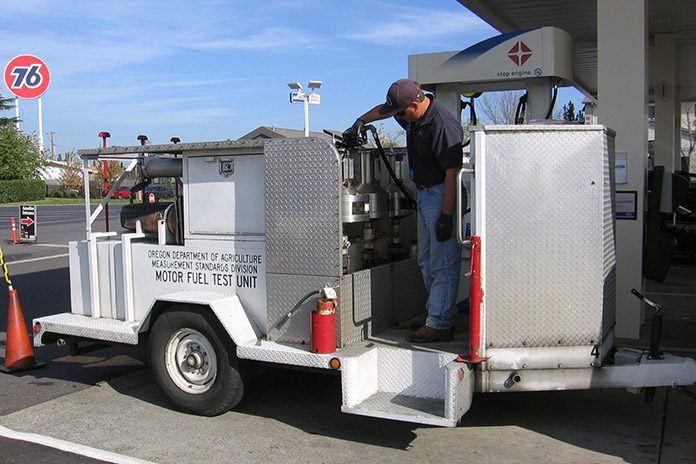
In general, motorists in Oregon can be confident they are getting good gasoline and diesel, based on Oregon Department of Agriculture statistics for 2017.
Routine ODA inspections this past year, along with responses to consumer complaints, indicate very few problems with the fuel. In an overwhelming majority of cases, drivers are getting what they pay for when they pull up to the pump at service stations throughout the state.
“Generally, motor fuel in Oregon meets specifications and is high quality to the point that consumers don’t even think twice about filling up the tank,” says Steven Harrington, deputy administrator of ODA’s Weights and Measures Program. “Overall, the quality of gasoline sold in Oregon appears to be very, very good and motorists are not likely to experience problems associated with motor fuels sold in the state.”
ODA’s 18 Weights and Measures field inspectors conduct annual fuel quality inspections nearly everywhere motor fuels are sold in Oregon. Inspectors check motor fuel at the pump for various quality standards including purity, visual clarity, octane ratings, and biofuel content. In addition, Oregon’s renewable fuel standard requires that, with a few exceptions, gasoline contains a 10 percent ethanol and diesel contains at least 5 percent biodiesel. ODA inspectors make sure those requirements are being met.
In 2017, ODA inspectors conducted 2,100 screenings of gasoline and diesel taken from nearly 30,000 Oregon fuel dispensers located at some 1,700 businesses throughout the state. The samples are routinely checked both for their octane rating and for visible contamination.
“When it comes to octane, it’s a relatively easy one to hide from consumers because they don’t have the ability to test it at the pump,” says Harrington. “Nevertheless, we don’t see problems. Last year, we screened 860 premium gasoline samples and found no significant issues with the octane posting on the pump.”
According to Harrington, there are a couple of obvious ways for a retailer to commit fraud in the gasoline market. An operator can over-order on their regular gasoline and ask that the tanker driver deliver the remainder in the premium gasoline tank, or an operator can tamper with the blending settings on their fuel dispensers. Motorists rely on ODA to conduct routine inspections of the fuel and to follow up on complaints when fuel quality issues are suspected.
In 2017, ODA responded to 14 consumer complaints, which are often generated when a vehicle breaks down leaving the owner with a potentially expensive repair bill. When the mechanic informs the vehicle owner that bad gas was the culprit, ODA is able to respond and help determine if the fuel was really the problem.
ODA inspectors regularly measure the amount of water in storage tanks to make sure it does not exceed state standards, using a stick with a water finding paste that turns pink upon contact with water. Any amount exceeding the standards requires the service station owner to remove the excess water so that it doesn’t end up in the consumer’s gas tank.
“Water is a concern for owners of underground storage tanks,” says Harrington. “All it takes is one leak anywhere in the system for rainwater or snowmelt to contaminate the fuel inside. ODA’s inspectors can issue off sale orders when the risk of passing that water on to the consumer is high.”
Last year, ODA screened 3,964 storage tanks. Those screenings showed 111 tanks having measurable water and 22 in excess of the tolerance. The results were roughly the same in 2016.
Some people may wonder if Oregon still needs to have a motor fuel inspection program, since there have been relatively few problems in recent years. Consider that more than 1.5 billion gallons of gasoline are sold annually based on fuels tax information provided by the Oregon Department of Transportation. Motorists in Oregon spend more than $3.8 billion annually on gasoline alone.








